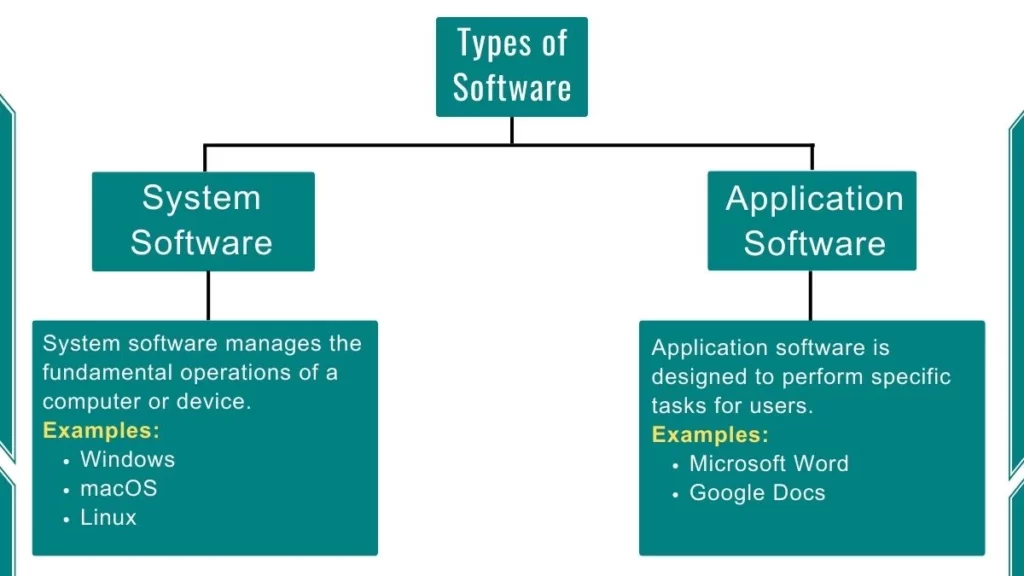Software is a set of instructions that tell a computer what to do. These instructions are source codes written in programming languages such as Python, Java, or C++. The source code is then converted into machine-readable object code or executable files, which can be run on a computer or other electronic devices.

Types of Software
Software can be broadly categorized into three main types:

- System Software: This type of software manages the fundamental operations of a computer or device. Examples include operating systems (e.g., Windows, macOS, Linux) and device drivers that control hardware components.
- Application Software: Also known as productivity software, application software is designed to perform specific tasks for users. Examples include word processors (e.g., Microsoft Word, Google Docs), spreadsheet programs (e.g., Excel, Sheets), media players, and web browsers.
- Embedded Software: This type of software is integrated into non-computing devices, such as consumer electronics, automobiles, and industrial machinery. Embedded software controls the functionality and behavior of these devices, enabling features like touchscreens, automatic transmissions, and safety systems.
Software Components
Software is typically composed of three main components:
- Source Code: This is the human-readable instructions written in programming languages by developers.
- Object Code: Once the source code is compiled or interpreted, it becomes machine-readable object code.
- Executable Files: These files contain the object code and can be executed or run on a computer.
Software Applications
Software applications can be broadly classified into three categories based on their intended use:
- Productivity Software: These applications are designed to assist users in completing tasks such as word processing, spreadsheet management, and presentation creation. Examples include Microsoft Office Suite and Google Workspace.
- Entertainment Software: This category includes various forms of multimedia software, such as video games, media players, and streaming applications.
- Educational Software: These applications are designed for learning and teaching purposes, ranging from educational games to online courses and reference materials.
Software Characteristics
Effective software should possess several key characteristics including:
- User Interface: How users interact with and control the software, such as a graphical user interface (GUI) or a command-line interface (CLI).
- Functionality: The set of features and capabilities provided by the software to meet user requirements.
- Reliability: The ability of the software to perform its intended functions consistently and accurately.
- Performance: The measure of how efficiently the software utilizes system resources, such as memory, processing power, and storage.
Software Development Life Cycle
From Idea to Implementation Creating software is a complex process that involves several stages, collectively known as the Software Development Life Cycle (SDLC). The SDLC typically includes the following steps:

- Requirements Gathering: Understanding the needs and objectives of the software project.
- Design: Planning the software’s architecture, user interface, and overall structure.
- Implementation: Writing the actual code that brings the software to life.
- Testing: Ensuring the software functions as intended and identifying and fixing any defects or errors.
- Deployment: Releasing the software for use by end-users.
- Maintenance: Updating and improving the software over time to address new requirements or fix issues.
Software Engineering
Building High-Quality Software Software engineering is the discipline of applying structured and systematic approaches to the development, operation, and maintenance of software. It encompasses principles such as modularity, abstraction, information hiding, separation of concerns, and reusability, all aimed at creating high-quality, reliable, and maintainable software products.
Software Architecture
The Blueprint for Software Systems Software architecture defines the structure and components of a software system, including the user interface, business logic, data access, services, and infrastructure. It serves as a blueprint for developers, helping them understand how the different parts of the software should interact and work together.
Software Testing
Ensuring Quality and Functionality Software testing is a critical step in the development process, as it helps identify and fix defects or issues before the software is released to end-users. There are various types of testing including:
- Functional testing: (verifying that the software meets its requirements).
- Non-functional testing: (evaluating aspects like performance, security, and usability).
- Regression testing: (ensuring that new changes haven’t broken existing functionality).
- Acceptance testing: (confirming that the software meets the client’s or stakeholder’s needs).
Software Licensing
Governing the Use and Distribution of Software Software licensing governs the legal use and distribution of software products. There are various licensing models, including:
- Proprietary: Software owned and licensed by a company or individual, such as Microsoft Windows.
- Open Source: Software with publicly available source code that can be freely used, modified, and distributed, like Linux and Mozilla Firefox.
- Freeware: Software that can be used without cost but with certain restrictions on distribution or modification.
- Shareware: Software that can be used for a trial period before requiring payment for continued use.
